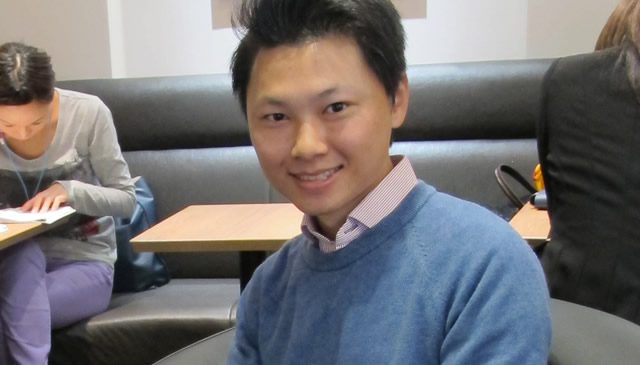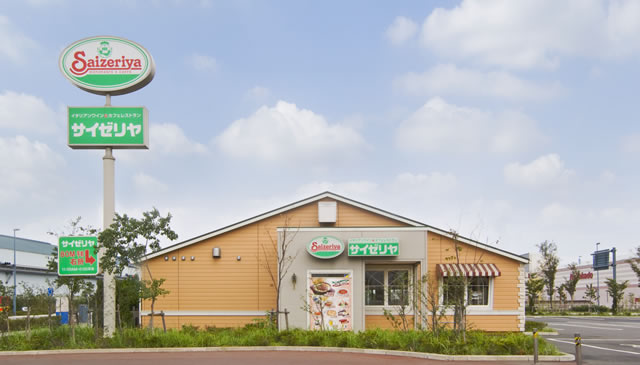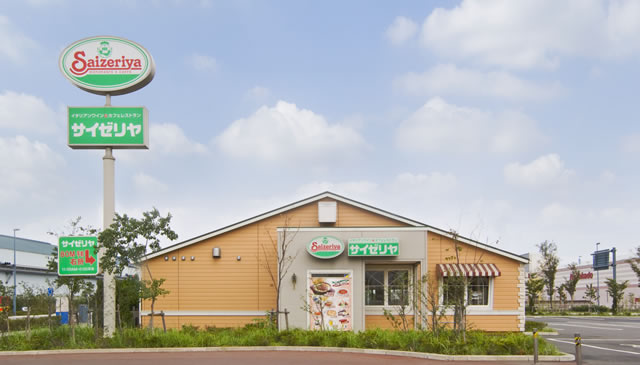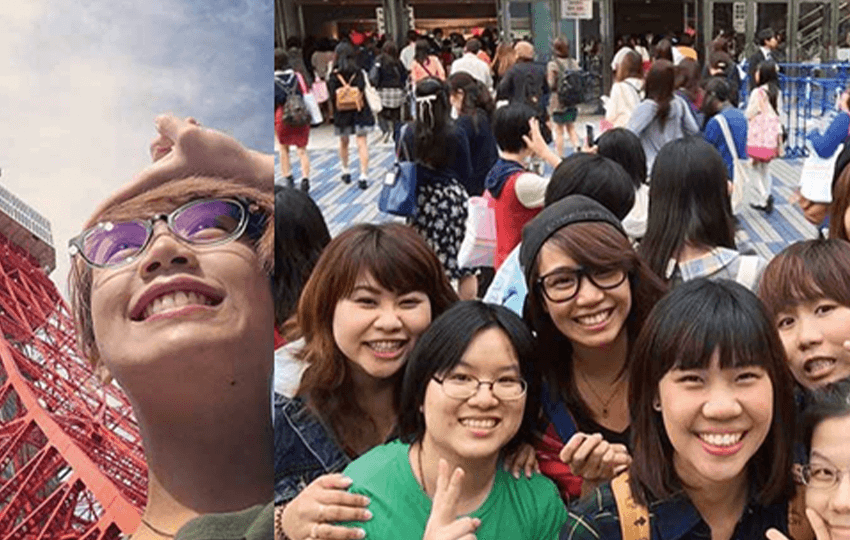-
[From January Issue 2015]
Yonex Co., Ltd
Badminton is a sport that flourishes in various Asian countries. During his foreign travels in October, 2013, Prime Minister ABE Shinzo presented the Bruneian King with a badminton racket. The gift given at that time was a product made by Yonex Co., Ltd – a company which produces and sells sporting goods.
At the Thomas Cup (a global men’s team badminton competition) held in May, 2014, the Japanese men’s team won for the first time. In October, the Japanese women’s team became the world’s top ranking team. Many top players use Yonex rackets.
Yonex was founded in 1946 in Niigata Prefecture under the name Yoneyama Company. Originally they made paulownia wood floats that were used by the fishing industry. However, they withdrew from float production when the materials used to produce them changed from wood to plastic. Around 1957, taking advantage of the badminton boom, they began producing rackets. Niigata Prefecture benefits from easy access to the kind of lumber that is suitable for making rackets with.
The company has gone through some tough times, including a fire that completely destroyed its factory and a bankruptcy crisis. However, they have diversified to become a sporting goods manufacturer that deals not only in rackets, but also in sports related items such as shoes and uniforms. The company has also concentrated its energies on product development, by developing materials from wood, aluminium, stainless steel, carbon, and more. In particular, the company is enthusiastic about making the most of the cutting edge materials of each era. In addition to badminton, the company also manufactures items related to other sports, including tennis, golf, and snowboarding.
The development of the Yonex badminton racket reflects the history of weight reduction and the pursuit of increased smash speeds through the adoption of graphite materials. In February 2013, the company created their lightest racket yet; the “Arc Saber FB,” that weighs 73 grams. In September, the Malaysian athlete TAN Boon Heong used the “Nanoray Z-speed” when he set a smash speed record of 493 kilometers per hour initial velocity. Furthermore, the square shaped “isometric form” racket that the company developed in 1980, had a huge impact on the tennis world, which up until then had favored rackets with a round shaped head.
The company name was changed to Yonex for overseas trading. “We removed a part of ‘Yoneyama,’ because it was difficult for foreigners to pronounce. Instead, we attached an ‘X’ to signify future possibility,” says TAKANO Yuzo of Yonex’s publicity department. This name reflects the company’s desire to create lighter and faster products in the future. Yonex has many contracts with sales agents throughout the world. The Yonex Cups for badminton and tennis are also held to make a contribution to the promotion of sport.
Photos courtesy of Yonex Co., Ltd
Text: ITO Koichi[2015年1月号掲載記事]ヨネックス株式会社
バドミントンはアジア各国で盛んなスポーツです。2013年10月には安倍晋三首相が外遊先であるブルネイの国王にバドミントンのラケットをお土産として渡しました。このときに贈られたのが、スポーツ用品を製造販売している株式会社ヨネックスの製品です。
2014年5月に行われたトマス杯(バドミントンの国別対抗戦)では、日本男子チームが初優勝を遂げました。10月には、日本女子チームが世界ランキングで第1位を獲得。多くのトッププレイヤーがヨネックスのラケットを使用しています。
ヨネックスは株式会社米山製作所として1946年に新潟県で創業。もともとは漁業で使う桐製の浮きを作っていました。しかし、素材が木からプラスチックに変わったため、浮きの製造から撤退。1957年頃バドミントンがブームになったのを機に、ラケットの製造を始めました。新潟県はラケットに適した木材を入手しやすいという利点もありました。
工場が火事で全部焼けてしまったり、倒産の危機があったりなど大変な時期がありました。しかしラケットだけでなく、シューズやウエアなどの関連アイテムも手がけるスポーツ用品メーカーとして事業を拡大。木製からアルミ、ステンレス、カーボンなど、素材の進化に合わせた製品開発にも力を注ぎました。特に、その時代の最先端の新素材を使った開発には熱心です。同社はバドミントンのほか、テニス、ゴルフ、スノーボードなどの関連用品を製造しています。
ヨネックスのバドミントンラケットの開発はカーボン素材の採用による軽量化とスマッシュスピードの追求の歴史でもあります。2013年2月に「アークセイバーFB」が同社最軽量の73グラムを実現。9月には、マレーシアのタン・ブンホン選手が「ナノレイ Z-スピード」を使い、初速で時速493キロメートルというスマッシュスピードを記録しました。また、1980年に同社が開発した「アイソメトリック形状」の四角い形のラケットは、それまで丸型が主流だったテニス界に大きな衝撃と変化をもたらしました。
ヨネックスという名前は海外と取り引きを始めるときに改められました。「Yoneyamaは長くて外国人が発音しにくいこともあり、一部を取り除き、代わりに未来の可能性を表す『X』を付けたのです」と宣伝部の高野祐三さんは話します。この社名には、より軽く、より速い性能をもつ未来の製品を作りたいという同社の願いが込められています。ヨネックスは世界の多くの国で代理店契約を結んでいます。バドミントンやテニスなどヨネックス杯も開催され、スポーツの振興に貢献しています。
写真提供:ヨネックス株式会社
文:伊藤公一 -
Bygone Days Still Beautiful
- Hiragana Times
- Jun 23, 2015
[From January Issue 2015]
Honey and Clover
Set in an art school, this work depicts the exploits of a group of young people who are awkwardly falling in love while trying to puzzle out their own futures. The series started in 2000, and was completed in 2006 after twice switching to different magazines. The animated cartoon televised in 2005 was so popular that a sequel was made the following year, and movie and TV drama adaptations have also been produced.
Along with his friends, who are attending the same school, TAKEMOTO Yuta lives a carefree life in a rundown apartment. One day he meets a young woman called HANAMOTO Hagumi. Due to enter art school the following academic year, she is on her way to visit her relative, the lecturer HANAMOTO Shuji. Takemoto falls in love the moment he sees Hagumi. However, at the same time, MORITA Shinobu, his senior, is also attracted to Hagumi.
Bowled over by Hagumi, who works on her art as if possessed, Takemoto gradually falls in love. Hagumi is blessed with an innate artistic talent, while Morita’s talents extend even beyond the artistic sphere, so the two are naturally drawn to each other. Takemoto, who considers himself to be mediocre, has an inferiority complex, so his heart is shaken by conflicting feelings of admiration and frustration towards the two.
Takemoto gradually realizes that Hagumi is experiencing a lot of pressure and is feeling isolated. Because she’s been praised for her talents from a young age, her classmates keep their distance from her, so until she meets Takemoto, she has no friends. Rather than force his feelings onto her, Takemoto decides to watch over Hagumi. In order to regain what she was unable to acquire before, Hagumi makes wonderful memories with Takemoto and friends.
Their limited school days draw to a close. While those around him choose their future careers, Takemoto’s job search falters and he buckles under the stress. In the end he repeats the year, postponing his graduation. When he finally obtains a promise of employment, the company goes bankrupt, so a brooding Takemoto sets off on an aimless bicycle trip. After spending a long period traveling, Takemoto sorts out his feelings and returns to his friends. And, though knowing that he will be rejected, he confesses his feelings to Hagumi.
Having considered Takemoto to be a close friend, Hagumi is perplexed. Additionally, just before graduation, a tragic event befalls Hagumi. Both Takemoto and Morita reach out to support Hagumi, but the decision that Hagumi arrives at massively alters her relationship with them.
The suffering caused by being unable to let someone know you like them and the angst that comes from being unable to visualize one’s own future are experiences anyone can identify with. Both for those people who hold something dear to their heart and for those who never look back, there is meaning in time spent together. This is what this story teaches us.
Text: HATTA Emiko[2015年1月号掲載記事] ハチミツとクローバー
ハチミツとクローバー
美術大学を舞台に、不器用に恋をして、手探りで未来を切り開こうとする若者たちを描いた作品。2000年に連載を開始し、その後掲載誌を2度移して2006年に最終回を迎えました。2005年に放映されたアニメは翌年に続編が作られるほど人気が高く、映画やテレビドラマも制作されています。
竹本祐太は、同じ大学に通う仲間たちと、ぼろぼろのアパートで楽しく暮らしていました。ある日、花本はぐみという少女に出会います。彼女は今年から美大に入学する予定で、親戚である講師の花本修司を訪ねてきたところでした。竹本は一瞬ではぐみに恋をしてしまいます。ところが同時に、先輩の森田忍もまた、はぐみに心を魅かれていました。
恋心がゆっくりと育っていく一方、何かにとりつかれたように創作活動に取り組むはぐみに、竹本は圧倒されます。天性の芸術的才能に恵まれたはぐみと、美術にとどまらず多くの才能を発揮する森田は、互いを認め合い近づいていきます。自分の平凡さに劣等感を持つ竹本は、二人に対する憧れと焦りが混じった感情に心を揺さぶられます。
竹本は次第に、はぐみの感じている重圧や孤独に気づきます。若くして才能を評価されているはぐみは同級生に敬遠されることも多く、竹本と出会うまで友人がいませんでした。竹本は自分の気持ちを押し付けるよりも、はぐみを見守る方を選びます。今まで手に入れられなかったものを取り戻すように、はぐみと竹本たちは思い出を積み重ねていきます。
学生時代という限られた時間は終わりへと向かっていきます。周囲が進路を決めていく中、竹本は就職活動が上手くいかないストレスで倒れてしまいます。留年して卒業が1年延びた末に、やっと決まった就職先が倒産、思いつめた竹本は自転車であてのない旅に出ます。長い旅路を経て、気持ちに整理をつけた竹本は、仲間たちのもとへ戻ってきました。そして受け入れられないと知りながら、ついにはぐみに思いを告げます。
竹本を大事な友人だと思っていたはぐみは、戸惑うばかりでした。さらに卒業を前にして、悲劇的な出来事がはぐみを襲います。竹本も森田も、それぞれはぐみを支えようとしますが、はぐみが下した決断は、彼らとの関係を大きく変えるものでした。
好きな人に気持ちを伝えられずに苦しんだり、先の見えない自分の未来に悩んだり、誰もが経験したことのある感情です。胸の中に何か大切なものを持つ人にとっても、二度と振り返らない人にとっても、一緒に過ごした時間には意味がある。それをこの物語は教えてくれます。
文:服田恵美子 -
Improving Japanese Ability by Being the Only Non-Japanese in the Workplace
- Hiragana Times
- Jun 23, 2015
[From January Issue 2015]
Lewis Winglam PONG
“I started studying Japanese when I came to Japan in September, 2013. I took the N3 (Japanese Language Proficiency) examination in December and passed. I took N2 in July, this year, and passed again. This month I took N1,” says Lewis Winglam PONG, from Hong Kong. In 2013 he began working at the Japanese head office of Sojitz Cooperation. Now he is working as an investment advisor in the structured finance division.
Pong majored in risk management and finance at Hong Kong University. Then, he went to study finance and management at a graduate school in the U.K., staying on to do an internship for two months. Before long, he got anxious about his parents and returned to Hong Kong, where he started job hunting. Then, he bumped into a friend who was employed by Sojitz who told him about working conditions there.
“What impressed me was that the company was hiring people who were not able to speak Japanese at all and giving them six months intensive Japanese instruction,” recalls Pong. Pong did some research into Sojitz. Learning that the company was a general trading company of a type unique to Japan, and that it was doing businesses in various fields around the world, he was intrigued.
“I became curious about Japan, too. Japan is poor in natural resources and suffers from many natural disasters, such as earthquakes. Despite suffering heavy damage in World War II, Japan regenerated itself in only a few decades to become the second biggest economy in the world,” says Pong.
Pong applied for a job at Sojitz and was hired. There, he received intensive Japanese instruction. “During the first three months, I received lessons to prepare for the N3 test in the morning at Waseda University and studied in a group of two to three people with one Japanese language teacher in the afternoon. Over the next three months, I studied with a Japanese language teacher in the morning and did on-the-job training, in other words learning Japanese from my colleagues while we worked.”
“Since I’m surrounded by Japanese people at work and the majority of business is in done in Japanese, it’s quite a challenge. For instance, at meetings, everybody speaks quietly and it’s sometime hard for me to catch what they’re saying. There were occasions when I could finally understand what the meeting was about after reading the minutes afterwards. In Hong Kong and the U.K., people try to show how confident they are by expressing their opinions in a loud voice, but in Japan it is a virtue to speak modestly. Also, when you have an objection, rather than say ‘I object,’ it’s customary in Japan to mention the reasons against it,” says Pong, smiling wryly.
He also had trouble with honorific expressions. “It is much more complicated than in Cantonese. In Japan you have to adjust your level of respect depending on whether you are talking to your manager or to a senior colleague. With people outside your company, you have to use another set of expressions. Honorific expressions used for communicating with them change according to which side is asking for a favour. Now, however, I naturally produce honorifics whenever I feel a sense of respect,” he says.
“I am hooked on snowboarding, which I started doing last year. I’m also enjoying golf,” says Pong, discussing his private life. “I used to think that if I’d gotten a job in Hong Kong, I wouldn’t have had such language difficulties. But now I feel that through studying Japanese I have widened my job opportunities. If I improve my Japanese, I’ll be given greater responsibility at work.”
Sojitz Cooperation
Text: SAZAKI Ryo[2015年1月号掲載記事]ルイス・ウィングラム・ポンさん
「2013年9月に来日して日本語の勉強を始め、12月にはN3、今年7月にN2を受けて合格しました。今月、N1を受験したところです」と香港出身のルイス・ウィングラム・ポンさんは言います。2013年、双日株式会社の日本本社に入社しました。今はストラクチャード・ファイナンス部で、投資のアドバイスをする仕事をしています。
ポンさんは香港大学でリスク管理と金融を専攻。その後、イギリスの大学院へ進学して金融と管理を学びました。そしてイギリスで2ヵ月ほどインターンをしました。やがてポンさんは両親が気がかりになって香港へ帰り、就職活動を始めました。その頃、双日に入社した友人と会う機会があり、仕事の話を聞きました。
「双日は、日本語がまったくできない人でも採用し、6ヵ月間も日本語の集中研修を受けさせてくれるのだという話が印象的でした」とポンさんは振り返ります。ポンさんは双日について調べました。そしてそこが総合商社という日本独自のスタイルの会社で、世界の各地でさまざまな分野の事業を行っていることを知って興味を持ちました。
「それに日本に対する好奇心もわいてきました。日本には天然資源がなく、地震など災害は多いです。その上第二次世界大戦で大きなダメージを受けたのに、たった数十年で復興し、経済力で世界2位にまでなりました」とポンさん。
双日に応募して採用されたポンさんは、日本語の集中研修を受けました。「最初の3ヵ月は、午前中は早稲田大学でN3対策の授業を受け、午後は日本語教師1人に対し生徒が2~3人で勉強するという環境でした。次の3ヵ月間は午前中日本語教師について勉強し、午後は会社でOJT、つまり仕事をしながら日本人の同僚に教えてもらいました」。
「会社では周りはみな日本人で、仕事もほとんどが日本語で進められるので大変です。例えば会議のとき、みんなの発言する声が小さいので僕には聞き取れないことがあります。後で議事録を読んで会議の内容がやっと理解できたこともあります。香港やイギリスでは大きな声で話して自信があることをアピールしますが、日本では控えめに話すことが美徳なんですね。また、反対するときは『反対です』と言うかわりに、反対する理由をたくさん言うのも日本の慣習です」とポンさんは苦笑します。
敬語にも苦労しました。「広東語の敬語より複雑で大変です。相手が上司か先輩かで敬語のレベルが変わりますし、社外の人に対してはまた別の表現になります。社外の人に対する敬語は、こちらがお願いする立場か、向こうがお願いする立場かで変化します。でも今は、敬意を感じると自然に敬語が出るようになってきました」と言います。
「昨年始めたスノーボードにはまっています。ゴルフも楽しんでいます」とポンさんはプライベートについて話します。「香港で就職していれば語学の苦労はなかったのにと思ったこともありますが、今は日本語を学んだことで、できる仕事の幅が広がったと感じています。日本語がうまくなれば、より責任ある仕事をさせてもらえるからです」。
双日株式会社
文:砂崎良 -
[From Decemberber Issue 2014]
Iwona KOZACZEWSKA,
Wife of the Republic of Poland Ambassador to Japan
“Poland has been through hard times in history; the territory was carved up by other countries and we suffered tremendous damage in WWII,” says Iwona KOZACZEWSKA. “We’ve nevertheless managed to rebuild and develop. The Poles are a nation that unites in adversity and can cooperate and strive for reconstruction. I believe we share this national character trait with Japanese. Our two peoples also have a similar sensitivity to music. The Polish musician Fryderyk CHOPIN is popular in both countries.”
Kozaczewska came to Japan in August 2012. “I was surprised by the heat and humidity of Japan’s summer. In Poland, the temperature in summer can rise close to 30°C, but it’s dry and pleasant,” she says. “I also had a hard time in Japanese cities because few streets have names. The subway at the beginning was very complicated, too.”
“When I get lost and open a map, however, a Japanese person immediately speaks to me to help me out,” Kozaczewska says with a smile. “Just the other day, I got lost while trying to walk on my own to the nearest station from our embassy. Almost immediately, a young Japanese lady offered me her assistance in getting to the station,” says Kozaczewska. “That kind of hospitability, too, reminds me of Poland.”
She has no difficulty as far as Japanese food is concerned. “Japanese food is great. I love soy sauce, okonomiyaki and miso soup. My husband always laughs because I get hungry and want to eat something as soon as we go out,” says Kozaczewska. “I often go to a conveyor belt sushi restaurant in Shibuya with my two daughters and I really enjoy the choice of ingredients. I was warned by many friends to be careful with nattou as its taste and smell are too much for non-Japanese to handle, but I thought it was interesting to taste it.”
Warsaw
She has no difficulty with raising her children in Japan, either. “In whatever country we are in, what we should teach and what we should tell them are the same,” says Kozaczewska. “It is also wonderful that they are having this opportunity to actually experience such an exciting country as Japan.”
Kozaczewska often travels around Japan with her family. “When we went to Hokkaido, one of our daughters was delighted. She said it was as if we were in Poland. The climate and landscape did indeed resemble our country,” says Kozaczewska.
“Last year, our family traveled to Hiroshima and Nagasaki to attend the A-bomb commemoration ceremonies. We learned about the tragedies caused by the atomic bombs and while traveling, we saw aspects of Japan – like the Japanese way of life – that you wouldn’t find in guide books. We decided to go there by car so that we could explore as many places in Japan as possible. The trip was long, but very meaningful,” she says. “Our daughters were happy that we stopped by Iga, the ninja town. Our elder daughter was particularly interested because she is called Iga herself.”
Japan has a lot of wonderful things that I’d like to take home to Poland: Japanese discipline and politeness; the attachment to tradition; beautiful kimono… Bonsai look spectacular. I’m also attracted to the beauty of pine trees. I found the ones at the Imperial Palace particularly fantastic. If I took home everything I liked in Japan, I’d be stopped at customs because there’s just too much,” she says smiling.
Tatra Mountains
“On the other hand, what I’d like to bring to Japan from Poland is food,” says Kozaczewska with a smile. “We presented Polish donuts, soup and smoked goat cheese at the recent Polish Festival at Roppongi Hills. They sold out right away. They are hard to find in Japan, so you should definitely eat them if you travel to Poland,” she says.
“I’m sure Japanese nature lovers will like Poland,” says Kozaczewska. “Poland still has primeval forest where European bison and storks live. The forests are full of mushrooms, so you can enjoy gathering them. In the Lake District, you can take boat cruises from lake to lake, as well as go fishing.”
“You can enjoy yachting and cruising on the northern Baltic coast, which is also known for its beautiful white beaches. The sand is so fine that even patterns created by the wind are beautiful. A lot of amber nuggets wash ashore on its beaches. As a child, I used to pick them up to present to my grandmother,” she says nostalgically.
“Poland also has lots of things of cultural interest,” says Kozaczewska. “Lazienkowski Park in the capital of Warsaw has the Palace on the Water as well as a famous statue of Chopin. Concerts are often held there. Many historical wooden churches are preserved in Małopolska and the Carpathians as they are listed as World Heritage Sites.”
Palace on the Water in Lazienki Park
“In the old capital of Krakow, there’s a museum of Japanese art and technology called ‘Manggha.’ Japanese comics are very popular with young people in Poland, too, but the Manggha of that museum has a different meaning,” says Kozaczewska, laughing. “Feliks JASIENSKI collected Japanese art, including ukyoe. He liked to be called by the nickname Manggha. The museum came to be called Manggha because it contains his collection. The film director Andrzej WAJDA, who’s known to be a Japanophile, was heavily involved with the construction of that museum.”
“Additionally, Wroclaw in southwestern Poland has a Japanese-style garden. As you can see, Poland has a lot of attractions and things related to Japan, so please come and visit. Our economic development in recent years has been remarkable and the streets are full of life,” says Kozaczewska.
“I would advise those foreigners studying the Japanese language to spend as much time as possible in Japan,” says Kozaczewska. “Japan has so many sides to it that it’s impossible to see everything in a short time. They should not only see the skyscrapers, Shibuya and tourist spots that are often shown on TV, they should also explore the back streets on foot. They’ll see that exotic Japanese scenes really exist, scenes that Europeans have seen only in children’s books.”
Photos courtesy of the Polish Embassy’s Tourism Office
Text: SAZAKI Ryo[2014年12月号掲載記事]イヴォナ・コザチェフスカさん
ポーランド共和国駐日大使夫人
「ポーランドは他国に国土を分割されたり、第二次世界大戦で大きな被害を受けるなど困難な時代を経てきました」と、イヴォナ・コザチェフスカ大使夫人は話します。「でも復興と成長をなしとげてきました。ポーランド人は困難にあうと団結して、復興のために協力しあって努力できる民族です。そういう国民性は日本人に似ていると思います。それに、両国の人々は音楽に対する感受性も近いです。どちらの国でも、ポーランド人音楽家フレデリック・ショパンが人気です」。
大使夫人は2012年8月に日本へ来ました。「日本の夏の暑さと湿気には驚きました。ポーランドも夏の気温が30度近くになりますが、からっとしていて過ごしやすいので」と言います。「それに日本のまちには、通りの名前があまりないので苦労しました。地下鉄がとても複雑なのも最初はわかりにくかったです」。
「でも私が道に迷って地図を広げると、すぐ日本人が声をかけて助けてくれます」と夫人はほほえみます。「つい先日も、大使館から最寄り駅まで一人で歩こうとして迷子になってしまいました。するとすぐに若い日本人女性が私を駅まで連れて行ってくれたのです」と夫人。「そういうおもてなしの心もポーランド人と同じです」。
日本の食べ物に関しては苦労していません。「日本食は最高です。しょう油、お好み焼き、味噌汁が大好きです。外出するとすぐ、おなかがすいたと言って何か食べたがるので、夫にいつも笑われています」と夫人。「娘2人を連れて、渋谷の回転寿司によく行って、本当にいろいろなネタを食べますよ。外国人にはがまんできない味とにおいの食品だから、納豆を出されたときには気をつけなさいと忠告してくれた友人が多かったのですが、味わってみるのもいいと思いました」。日本で子育てをすることにも苦労はありません。「どの国にいても、子どもに教えるべきこと、伝えなければいけないことは変わりません」と夫人は言います。「日本というわくわくする国を実際に体験させられる点もすばらしいです」。
夫人は家族とよく日本国内を旅行します。「北海道へ行ったとき娘が、まるでポーランドへ来たみたいと喜びました。確かに気候も風景もよく似ているんです」。
「昨年は原爆記念式典に出席するため、一家で広島と長崎へ行きました。そこでは原爆の悲惨さを学び、移動中には日本人の生活ぶりなどガイドブックには載っていない日本の一面を見ました。日本のさまざまな場所を見るために車で行ったんですよ。長い旅でしたが、とても有意義でした」と言います。「娘たちは途中で忍者の町、伊賀に寄ったのを喜んでいました。上の娘は、自分の名前がイガなので、特に興味を持っていました」。
「日本には、ポーランドへ持って帰りたいと思うすばらしいものがたくさんあります。日本人の規律や礼儀正しさ、伝統を大切にする心、美しい着物……盆栽もすばらしいですね。松の木の美しさにもひかれます。特に皇居の松はすばらしかった。日本で好きになったものを全部持ち帰ったら、あまりに多すぎて税関で止められてしまいますよ」と笑いながら話します。「逆に、ポーランドから日本へ持ってきたいものも、やはり食べ物ですね」と笑う夫人。「ポーランドのドーナツとスープ、ヤギの乳の薫製チーズなどを、この間六本木ヒルズで開催したポーランド祭りで並べたところ、たちまち売り切れました。日本では入手しにくい食品なので、ポーランドへ旅行したらぜひ食べてみてください」。
「日本人は自然が好きですから、絶対にポーランドが好きになりますよ」と夫人は言います。「ポーランドには原生林が残っていて、ヨーロッパバイソンやコウノトリが生息しています。森にはキノコが多くて、キノコ狩りが楽しめます。湖水地方には、とても多くの湖が連なっていて、ボートで湖から湖へクルージングしたり、釣りもできます」。
「北部のバルト海沿岸は、ヨットやクルージングが楽しめるだけでなく、白い砂浜の美しさでも知られています。砂がとても細かいので、風に吹かれてできる模様もきれいです。浜辺には琥珀が打ち上げられていますよ。私は子どもの頃、たくさん拾い集めて祖母にプレゼントしました」と夫人は懐かしそうに話します。
「ポーランドには文化的な見どころもたくさんあります」と夫人。「首都ワルシャワのワジェンキ公園には、水上宮殿やショパンの有名な像があり、コンサートもよく開催されています。マウォポルスカ地方やカルパチア地方には歴史的な木造の教会が多く残されていて、世界遺産に登録されています」。「古都クラクフには『マンガ』と呼ばれる日本美術技術博物館があります。日本のコミックはポーランドでも若者たちに大人気ですが、この博物館のマンガはその意味ではないんです」と夫人は笑います。「かつて、フェリックス・ヤシェンスキという熱心な浮世絵などの日本画コレクターがいて、彼はマンガというあだ名を好んで使っていました。それで、彼のコレクションを収めた博物館がマンガと呼ばれることになったのです。また、この博物館の建設には、日本通として知られる映画監督アンジェイ・ワイダ氏が深く関わっているんですよ」。
「そのほか、ポーランド南西部のヴロツワフには日本庭園があります。このようにポーランドには、見どころや日本と関わりのあるものが多いですから、ぜひ見に来てください。最近は経済成長がめざましくて、まちもとても活気づいていますよ」と夫人は言います。
「また、日本語を勉強している外国人の方には日本にできるだけ長く滞在してくださいと言いたいです」と夫人。「日本にはいろいろな顔があります
から、短期間では見きれません。テレビでよく取りあげられる高層ビル群や渋谷、観光スポットだけでなく、裏通りも歩いてみてください。ヨーロッパ人にとってはおとぎ話の中でしか見たことのない、エキゾチックな日本の風景が現実に存在していますから」。
写真提供:ポーランド共和国大使館
文:砂崎良 -
[From Decemberber Issue 2014]
WASARA Co., Ltd.
With the goal of creating high quality plates and utensils that are disposable yet stylish, WASARA was created of in 2008. Because of their unique high quality designs and environmental friendliness, WASARA plates were used at an opening event of the G8 Hokkaido Toyako Summit as soon as they were launched on the market. Since then, the plates have been prized for their ability to make any dish look appealing, and they are now even used at Michelin-starred restaurants.
The most important feature is the way the range of 18 items – which includes plates, cups and utensils – goes so well together. Speaking about various inquiries the company receives from its customers, SHIMA Shinako, brand manager of WASARA Co., Ltd., says, “I realized the hospitality industries had been looking for disposable tableware that compliments the cuisine served on it.”
Designs are simple but, through attention to detail, they show off food to its best advantage. Pulp is pressed into a mold that has a ridged surface giving the finished product the feel of washi (Japanese craft paper), and the plates are cut in such a way that the edge is beautifully finished. Fulfilling such specifications requires a high level of craftsmanship. To develop these unique paper plates, technical help was brought in from sources that usually have no connection to the manufacturing of paper plates; such as from factories that usually produce molds for screws used in cars.
WASARA’s parent company, Itokei Co., Ltd., manufactures and sells containers for desserts and ice cream. In the days preceding Itokei’s 100th anniversary, management thought about what direction the company should take in the future and decided to create high-value-added products that could be passed down to future generations.
Plates and bowls are made of bagasse – fibrous matter that remains after the juice is squeezed out of sugarcane – and also of bamboo, which is known for being a fast-growing plant. WASARA’s utensils are made of bamboo. So that they can be returned to the earth after use, they aren’t laminated. If you put them into a compost container, they can be reused as compost.
Compared with Japan, there are more opportunities abroad for catering and parties, so in the first four years subsequent to the launch of WASARA’s products, exports exceeded domestic sales. These products are currently on sale at nearly 100 shops overseas, mostly in the West. Shima, however, analyzes the situation with a level head, saying, “There are challenges to overcome, such as the issue of distribution costs due to rising oil prices.”
A set of six medium-sized plates costs 540 yen (including tax), not exactly reasonable compared with regular paper plates. But sales in Japan have been increasing, too. According to Shima, one of the reasons they are selling well is that more and more people actually use them and appreciate their value. The product’s strongest selling point is its eco-friendliness and its additional value of being a disposable item that incorporates a design that makes dishes look delicious.
WASARA Co., Ltd.
Text: ICHIMURA Masayo[2014年12月号掲載記事]株式会社WASARA
使い捨てだけどデザイン性と品質を兼ね備えた食器を作ろう。WASARAは、そうした意図のもとに企画され2008年に誕生しました。誕生と同時にこれまでにないデザイン性の高さと環境に配慮したコンセプトから、北海道洞爺湖サミットのウェルカムイベントで使用されました。その後もどんな食事も映えると評価され、ミシュランの星付きレストランなどで使われています。
皿やコップ、フォークなど全部で18種類あり、統一感を持って使用できるのも大きな特徴です。各方面からの問い合わせに「ケータリング産業では、使い捨てだけど料理に合う食器群を探していたのだと思いました」と株式会社WASARAのブランドマネージャー、島梓無子さんは言います。
シンプルなのに料理を引き立てるデザインは細かなこだわりを施すことで生まれています。パルプをプレスする金型に凹凸を施して和紙のような質感にしたり、器のふちをきれいにカットしたりしています。こうした仕様にするには高い技術が必要でした。普段は車のネジの金型などを作っている工場など紙皿とは関係ない分野の技術協力を得て、これまでにない商品を生み出したのです。
親会社の伊藤景パック産業株式会社は、デザートやアイスクリームを盛り付ける容器などを製造・販売しています。創業100周年を迎える前にこの先の会社としてのあり方を考え、後世に残すことのできる付加価値の高いものを作っていこうと決まりました。
器はさとうきびのしぼりかすであるバガスと、生命力の強い竹が使われています。ナイフ、フォーク類には竹が使われています。どれも使用後は土に戻せるよう、ラミネート加工などはされていません。堆肥化する容器に入れれば、堆肥として再利用することも可能です。
日本に比べて海外はケータリングやパーティーの機会が多いので、発売から4年は輸出のほうが好調でした。現在は欧米を中心に100近くの店で販売されています。しかし「石油価格の高騰などによる流通のコストなどクリアしなければいけない課題も残っています」と島さんは冷静に分析しています。
中型の皿が6枚で540円(税込)と通常の紙皿と比べると手頃な価格ではありませんが、国内の消費も伸びています。島さんは実際に使って価値を理解してくれた人が増えているためだと考えています。高いエコ意識と、使い捨てる物なのに料理をおいしく見せるデザイン--この付加価値が、大きな強みとなっています。
株式会社WASARA
文:市村雅代 -
[From Decemberber Issue 2014]
This restaurant theater opened in April this year. Wahaha Hompo, a troupe known for its eccentric costumes and performances is now giving its first performance of Gorakuza” (Entertainment Theater) – an original work specially made for the theater. (Admittance: 4,500 yen. On top of this customers must order at least one drink.) Including characters and music that will even be familiar to non-Japanese, this is a show that everyone can enjoy. In addition there is a permanent exhibition of Asakusa’s streets reproduced on panels and in dioramas, the “Secret Hideout of About 100 Square Meters” (costs 500 yen), and screenings of movies associated with the town (1,000 yen).
Access: Four-minute walk from the A1 exit of Taharacho Station on the Tokyo Metro Ginza Line
Address: ROX1F Entrance, 1-25-15 Asakusa, Taito Ward, Tokyo
Business hours: 9:30 a.m. – 9:00 p.m. (depending on the program)
Asakusa Rock Yumemachi Theater
Text: KAWARATANI Tokiko[2014年12月号掲載記事]今年4月にオープンした、レストランシアター。奇抜な衣装やパフォーマンスが特徴の劇団「ワハハ本舗」が、当劇場用に「娯楽座」を旗揚げして公演中(料金:4,500円、別途1ドリンクオーダー必要)。外国人にもなじみのある人物や音楽を取り入れ、誰でも楽しめる内容にしている。浅草の町をパネルやジオラマで再現した常設展「三十坪の秘密基地」(500円)や、浅草にちなんだ映画の上映(1,000円)もある。
交通:東京メトロ銀座線田原町駅A1出口徒歩約4分
所在地:東京都台東区浅草1-25-15 ROX1F専用入口
営業時間:午前9時30分~午後9時(演目によって異なる)
浅草六区ゆめまち劇場
文:瓦谷登貴子 -
[From Decemberber Issue 2014]

“Italian Wine & Cafe Restaurant Saizeriya” have over 1,000 branches both in Japan and overseas. The interiors are decorated in an Italian style and wines, olive oil and cheeses are imported from Italy. Even if they eat there every day, customers never tire of the simple seasoning and reasonable prices. Easily complimenting the main dishes, the soups, side dishes, wine, and soft drinks are particularly good value. In addition to Italian food, gratin, hamburger steaks, and more, are also on the menu.[No. 1] Doria (baked rice and cheese gratin-style) Milanese, 299 yen
One third of customers order this. Building on 40 years of ongoing research, the dish has been repeatedly improved upon. The rich meat sauce and white sauce is popular.

[No. 2] Shrimp Salad, 299 yen
Salad topped with tender deep-water shrimps. After being harvested, the lettuce is kept at a temperature of four degrees centigrade and is chopped before being delivered to restaurants.

[No. 3] Spicy Hot Chicken, 299 yen
After being dipped in sauce, the chicken is seasoned with an original blend of spices. It’s popular for its juiciness and crispy texture. Since it has a mild taste, children can eat it, too.

Price includes tax.
Saizeriya[2014年12月号掲載記事]「イタリアンワイン&カフェレストラン サイゼリヤ」は海外を含め千店舗以上を展開。店内の内装やインテリアはイタリア風になっており、ワイン、オリーブオイル、チーズなどは現地から輸入している。毎日食べてもあきないよう、味付けはシンプルに、手頃な価格で提供しているのが特徴。特にスープ、おつまみ、ワイン、ドリンクバーはメインの料理と組合せやすいように価格設定されている。イタリア料理に限らず、グラタンやハンバーグなどのメニューもある。
【No.1】ミラノ風ドリア 299円
お客の3人に1人が注文。40年間研究を続け、改良を重ねている。ミートソースとホワイトソースの濃厚な味わいが人気。
【No.2】小エビのサラダ 299円
プリプリとした食感の甘エビをトッピングしたサラダ。レタスは収穫後すぐに4℃前後に保ち、カットして店へ運んでいる。
【No.3】辛味チキン 299円
たれにつけ込んだ後、オリジナルで配合したスパイスで味付けしている。ジューシーさと、サクッとした皮の食感が人気。マイルドな味つけなので子どもでも食べられる。
Price includes tax.
サイゼリヤ -
[From Decemberber Issue 2014]
KATSURA Kaishi, Rakugo-ka
In Japan there is a comic form of entertainment called “rakugo” (comic storytelling) which has been around for approximately 400 years. It features one person portraying many different characters. The storyteller sits down on a cushion and spins a tale using only a tenugui (Japanese thin towel) and a sensu (folding fan) as props. The performer is called a rakugo-ka (comic storyteller) and in theaters that specialize in rakugo in Tokyo and Osaka, performances take place every day.
Based in Kansai, KATSURA Kaishi continues to translate and perform classic rakugo stories in English. Since 1998, he has successfully performed over 300 times in 97 cities in 17 countries worldwide. “I started this partly because I loved English and longed for a chance to study abroad. My master (the late KATSURA Bunshi V) generously gave his permission, even though it was shortly after I had completed my apprenticeship.”
“At the outset, even in Japanese, I only had seven or eight stories in my repertoire,” says Kaishi. But now, after receiving many awards including the Ministry of Culture Rookie of the Year Award, and the NHK Japan National Television Award for Young Artists, he is beginning to gain acknowledgment for his abilities in Japan. Subsequently, he was appointed as the cultural ambassador of the Agency for Cultural Affairs and went on a six-month English rakugo tour in the United States.
“Driving the camper van myself, I toured around 33 cities with my family. In rakugo, movement – for example miming eating with chopsticks with a sensu or sewing with tenugui – is more important than words. It was very difficult to explain to local staff that it is typically performed on a high platform called a kouza (stage) so that the entire body is visible. They said that it was too dangerous and I had to sign a written waiver that said I would not sue even if I were injured.
“I was worried when I visited the township of the Native Indian Navajo tribe and was told that these people rarely laugh. When I tried a kobanashi (short story) about Monument Valley, there was applause and laughter from the audience and the rakugo also got a huge laugh. I was very pleased that people who knew nothing of Japan or rakugo enjoyed it,” he continues.
Performing as part of a group, I took part in the “Edinburgh Festival,” the world’s largest drama festival, in August this year. The performance, which brought to mind a “Japanese Cirque du Soleil,” consisted of physical performances, including Japanese dance, taiko (Japanese drums), and aerial dance, combined with CGI.
“The production shows how sake is created; in the role of the touji (the person in charge of a sake brewery), I was MC for the whole performance. Before the rakugo, I appeared in front of the audience with a sake bottle in my hand and gestured for them to have a drink; I was very nervous, since it was a new experience for me.” It got the highest five star rating from the “British Theater Guide” and was highly praised by the fair and exacting local media.
With his English rakugo, Kaishi has continued to break out of the rakugo sphere, by collaborating with other art forms, including bunraku (Japanese puppet theatre). “Whether it be Japan or abroad, I’d like to go anywhere where I can give pleasure with my rakugo. I’d like my dream to study drama in London to come true, too,” he says with a radiant smile.
Office Beginning
Text: KAWARATANI Tokiko[2014年12月号掲載記事]
落語家、桂かい枝さん
日本には約400年前から続いている笑いの芸能「落語」があります。一人で何人もの人物を演じるのが特徴です。座布団に座り、道具は手ぬぐいと扇子だけを使って表現します。演じる人を落語家といい、東京と大阪にある落語専門の劇場では、毎日公演が行われています。
関西を拠点に活躍している桂かい枝さんは、古典落語を自ら英語に訳し、そして演じる活動を続けています。1998年から世界17ヵ国97都市で、300回を超える公演を成功させてきました。「英語が好きだったのと、留学に憧れていたこともあって始めました。師匠(故五代目桂文枝)は、修行期間があけて間もない頃だったのにおおらかに許してくれました」。
「最初は日本語ですら持ちネタが7つか8つでした」とかい枝さんは話します。今では文化庁芸術祭新人賞、NHK新人演芸大賞など多くの賞を受賞し、日本での実力も認められています。その後、文化庁より文化交流使に任命され、半年かけてアメリカで英語落語ツアーを行いました。
「自分でキャンピングカーを運転して、家族と一緒に33都市を回りました。落語は扇子をはしに見立てて食べる表現や、手ぬぐいで縫い物をする演技など、言葉以上に動きも大切です。高座と呼ばれる高い台に乗って全身を見せるのが通常ですが、現地スタッフに説明するのは大変でした。危険だと言われて、けがをしても訴えないという誓約書を書いたこともありましたね」。
「ネイティブアメリカンのナバホ族の居住区では、彼らはめったに笑わないと聞かされて不安でした。モニュメントバレーに関する小噺(短い落語)をやってみたら、客席から拍手と笑い声が起こって、落語も大爆笑でした。日本や落語を知らない人たちに喜んでもらえて、本当に嬉しかったですね」と続けます。
今年8月には、イギリスで開催された世界最大の演劇祭「エディンバラフリンジ」に、パフォーマンス集団の一員として参加しました。日本舞踊、太鼓、空中ダンスといった身体表現とCG映像を合わせた「和製シルク・ドゥ・ソレイユ」を思わせる内容です。
「酒が誕生する様子を表した作品です。杜氏(酒の製造過程を取り仕切る役目)役で、全体の進行係でした。落語の前に酒瓶を持って客席から現れて、お客さんにお酒を勧める仕草をしたりしましたが、初めての経験だったので最初は緊張しましたね」。イギリス舞台専門雑誌「British Theater Guide」で最高評価の五つ星を獲得し、公平で厳しい現地メディアから大絶賛されました。
かい枝さんは、英語落語や文楽など他ジャンルとのコラボレーションと、落語家の枠組みを超えた活動を続けてきました。「日本でも外国でも、ぼくの落語で喜んでもらえるなら、どこへでも出かけていきたいと思います。ロンドンでの演劇留学の夢も叶えたいですね」と、晴れやかな笑顔で話します。
文:瓦谷登貴子
-
[From Decemberber Issue 2014]
Autobacs Seven Co., Ltd.
A s well as carrying out mandatory vehicle inspections and maintenance, Autobacs Seven Co., Ltd. sell, install and change car parts. The company was originally a wholesale dealer in car parts. However, in order to get new business ideas, founder SUMINO Toshio visited the US to take a look at the distribution business there. During that visit he was bowled over when he saw one-stop shops that not only sold all kinds of car parts, but installed them and carried out repairs in the same location.
In those days tires, oil and batteries were sold separately in specialized shops in Japan. Customers therefore had to visit several shops to buy the parts and products they wanted. Convinced that the customer-friendly one-stop business style would be welcomed in Japan, Sumino opened his first Autobacs shop in November 1974 in Daito City, Osaka Prefecture.
Sumino came up with a striking company name to call attention to this revolutionary new business style. The first two letters in Autobacs represent the company’s philosophy, while the remaining six represent the range of products on offer. A stands for appeal, U for unique, T for tires, O for oil, B for batteries, A for accessories, C for car electronics, and S for service.
The company name is Autobacs Seven, but the name of the store is Autobacs. “Seven” signifies the continuing search for a seventh product line. The orange corporate color stands out even at a distance and represents a pioneering spirit and Californian orange. It’s also influenced by the image of the American sunshine seared into Sumino’s eyes.
The company’s three bestselling products are “studless tires,” “tire chains,” and “car cleaning supplies.” Studless tires are a must for safe driving in regions such as Hokkaido, Tohoku and Hokuriku where there is a great quantity of snow. There is more demand for chains for emergency use when there is heavy snow in and around large cities like Tokyo and Osaka. Car cleaning supplies sell more in early spring when the air is filled with cedar pollen and yellow dust from mainland China.
ONODA Kenichi of the PR department stresses, “We are second to none in that we have one of the largest shop networks in Japan, a high brand recognition, a comprehensive product lineup, excellent service, and a team of professionals.” Each shop strives to be customer-friendly by displaying products according to their use and by using integrated signage.
Autobacs attaches importance not only to its products and services, but also to customer service. In order to avoid any unpleasantness, customers are treated well and provided with satisfactory products. Staff are trained on the importance of personal grooming, smiling, eye contact, greetings, polite phrasing, and bowing. “We work hard to maintain and improve our Autobacs brand,” says Onoda.
Autobacs Seven Co., Ltd.
Text: ITO Koichi[2014年12月号掲載記事]株式会社オートバックスセブン
株式会社オートバックスセブンは、カー用品の販売や取り付け、交換、車検、整備などを行っています。もとは自動車部品の卸売業でした。しかし、新しいビジネスのヒントをつかむため、創業者の住野利男さんはアメリカの流通業を視察しました。そのとき、あらゆる自動車用品を1ヵ所で販売し、その場で取り付けや整備ができるワンストップ型の店舗を見て衝撃を受けました。
当時の日本はタイヤやオイル、バッテリーなどは専門店で別々に売られるのがあたり前でした。そのため、ユーザーはいくつかの店を回って、ほしい部品や用品を買う必要がありました。住野さんは、ユーザーの利便性を高めるワンストップ業態は日本でも受け入れられると確信し、1974年11月、大阪府大東市にオートバックス1号店をオープンしました。
それまでにはなかった、まったく新しい形態を訴えるため、住野さんは印象的な社名を考えました。「AUTOBACS」は最初の2文字がコンセプトを表し、残りの6文字が取り扱う商品群を表しています。Aはアピール、Uはユニーク、Tはタイヤ、Oはオイル、Bはバッテリー、Aはアクセサリー、Cはカーエレクトロニクス、Sはサービスです。
会社の名前はオートバックスセブンですが、店の名前はオートバックスです。「セブン」には7つ目の商品を探し続けるという意味が込められています。遠くからでも目立つコーポレートカラーのオレンジ色は、開拓者精神とカリフォルニア産オレンジを表します。住野さんがアメリカで目に焼き付けた輝く太陽のイメージも影響しています。
年間の売れ筋商品は「スタッドレスタイヤ」「タイヤチェーン」「洗車用品」の3つ。スタッドレスタイヤは北海道や東北、北陸など、降雪の多い地域では安全運転のための必需品です。チェーンは東京、大阪などの都市圏を中心に積雪時の緊急用として需要が伸びます。洗車用品はスギ花粉や中国大陸からの黄砂が舞う春先によく売れます。
広報部の小野田健一さんは「国内最大級の店舗ネットワークと高いブランド認知度、多彩な品揃えと充実したサービス、車のプロフェッショナル集団という点では、どこにも負けません」と強調します。個々の店舗では用途別の陳列や統一された店内表示による、わかりやすく買いやすい売り場づくりを進めています。
オートバックスは商品やサービスばかりでなく、接客にも力を入れています。それはお客を不快にさせず、良い買い物ができたと満足してもらうための土台です。そのため、身だしなみや笑顔、アイコンタクト、あいさつ、言葉遣い、お辞儀などのトレーニングをしています。「オートバックスブランドの維持と向上に努めています」と小野田さんは話します。
株式会社オートバックスセブン
文:伊藤公一 -
Inspired To Go To Japan By Japanese Idols
- Hiragana Times
- Jun 03, 2015
[From Decemberber Issue 2014]
Rassawan KONDEJADISAK
“I like Japanese idols,” says Rassawan KONDEJADISAK, describing the interest that brought her over from Thailand to Japan. “I especially like Johnny’s ‘Hey! Say! JUMP’ When I was watching their concerts on TV programs and DVDs, I felt I wanted to study Japanese because I wanted to understand what they were saying.”
Rassawan came to Japan in 2011 and without delay entered Yokohama Design College. Although the school specializes in design, they also have a Japanese language course aimed at foreign students. Rassawan, who had not studied Japanese before, started with the basic reading and writing of “a, i, u, e, o.”
“I did not understand any Japanese,” says Rassawan. “I could not read books nor magazines and I could not understand what they were talking about on TV. At first I was quite worried because I could not even manage basic conversation. But by continuing with my studies, I gradually became able to understand Japanese and that made things surprisingly enjoyable.”
“Now I can read books that I could not! I can understand conversation that could not! Before I knew it, the uneasiness in my heart changed to joy. I wanted to study more and more every day and I wanted to know more about things I was ignorant of.”
“Although three years have passed since I started to live in Japan, there are still many things I cannot understand about the Japanese sensibility. Why do I have to do this? Why don’t I have to do that? Sometimes it is a mystery to me. There are some similarities to the Thai way of thinking, but other things are totally different.”
“I felt uneasy when I became a fully paid up member of Japanese society. But I don’t want to limit myself to just Japan and Thailand, I want to understand the feelings of people in other countries, too.” Rassawan is now doing PR work at Relation Japan., Inc., promoting Japan to Thailand. The company produces advertisements for Japan in various media, including travel magazines and TV, it also operates booths at travel fairs. Rassawan is in charge of design and of communication with Thailand.
“Japan is a country that places importance on public order. It is quite different from Thailand, which has an easy-going attitude. But I am really happy because the people of both countries are kind hearted.” On her days off, she often goes to Shibuya, Harajuku, and Omotesando. “I enjoy going to stylish cafes. I like reading books in such places. And, of course, in the concert season I go to concerts!”[2014年12月号掲載記事]
ラッサワン・コンデッチアディサックさん
「私は日本のアイドルが好きです」とタイから来たラッサワン・コンデッチアディサックさんは日本に興味を持ったきっかけを話します。「特にジャニーズの『Hey! Say! JUMP』というグループが大好きです。テレビ番組やDVDでコンサートを見ているとき、彼らが何を話しているのか知りたくて、日本語を勉強したいと思いました」。
ラッサワンさんは2011年に来日し、すぐに横浜デザイン学院に入学しました。ここはデザインの専門学校ですが、留学生向けの日本語学科があります。ラッサワンさんはそれまで日本語の勉強をしたことがありませんでしたが、日本語の基本である「あいうえお」の読み書きから始めました。
「私は日本語が全くわかりませんでした」とラッサワンさん。「本や雑誌も読めなかったし、テレビを見ても理解できなかったです。日常会話すらできなかったので最初はすごく不安でした。でも勉強を続けるうちに日本語がだんだんとわかってきて、そうすると驚くほど楽しくなりました」。
「今まで読めなかった本が読める! わからなかった会話がわかる! 心の中にあった不安感がいつの間にか楽しさに変わりました。毎日もっと勉強したくて、知らないことをもっと知りたいと思いました」。
「日本に住んで3年目ですが、日本人の感覚が理解できないことがまだまだ多いです。なぜこのようなことをしなければならないのだろうとか、なぜこれはやらなくても良いのかなど、不思議に思うことがあります。タイ人と同じような考え方もあれば、全然違う考え方もあります。
「日本で社会人になるときは心配になりました。でも日本人やタイ人に限らず、いろいろな国の人の気持ちを理解できるようになりたいです」。ラッサワンさんは今、株式会社Relationでタイに向けて日本をPRする仕事をしています。旅行雑誌やテレビなどメディア向けに日本の広告を制作したり、タイで行われる旅行博などでブースのデザインや運営などを行う会社です。ラッサワンさんの担当は、デザイン関係やタイとのやりとりです。
「日本は社会の秩序を大事にする国です。タイは気楽な国なので全然違うと思います。でも、タイも日本も人々が親切な心を持っているので、本当によかったです」。休みの日は渋谷、原宿、表参道などへ行くことが多いといいます。「おしゃれなカフェに行くのが楽しいです。そこで本を読むことが大好きです。そしてもちろん、コンサートのシーズン中は、コンサートを観に行きます!」
Information From Hiragana Times
-
 February 2026 Issue
January 21, 2026
February 2026 Issue
January 21, 2026 -
 January 2026 Issue – Available as a Back Issue
January 15, 2026
January 2026 Issue – Available as a Back Issue
January 15, 2026 -
 December 2025 Issue —Available as a Back Issue
November 20, 2025
December 2025 Issue —Available as a Back Issue
November 20, 2025


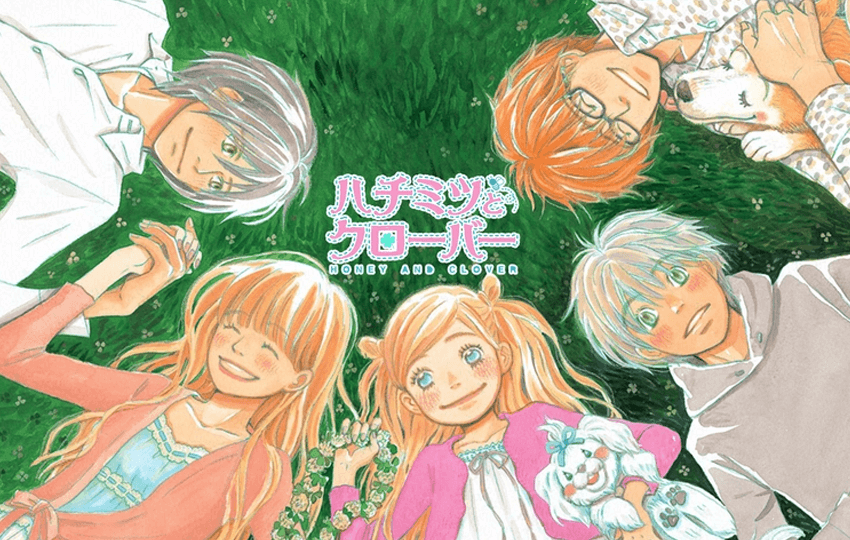
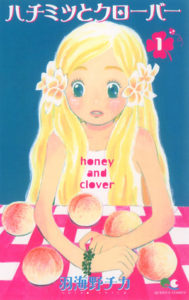 ハチミツとクローバー
ハチミツとクローバー